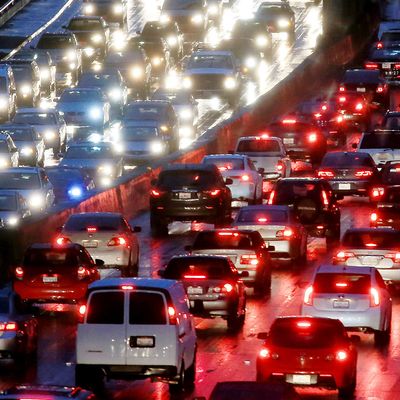
You know you have a real controversy on your hands when the fossil-fuel lobbyist you’ve placed at the head of the nation’s chief environmental agency is balking at a major deregulatory action. Recently appointed EPA administrator Andrew Wheeler is reportedly alarmed that a long-planned freeze in auto fuel-efficiency standards, along with a revocation of California’s long-standing waiver to set its own standards (which are followed by 13 other states), will go too far. And he’s been joined by the primary intended beneficiary of the proposal, auto manufacturers, who fear it will lead to endless litigation that will leave them in the dark about future regulatory requirements.
But all these concerns have been brushed aside as EPA officially announced the big rollback of auto emissions regulations today, representing a major blow to decades of efforts to reduce air pollution and mitigate climate change. The New York Times offered a brief description:
The Trump administration’s proposal, jointly published by the Environmental Protection Agency and the Transportation Department, would roll back a 2012 rule that required automakers to nearly double the fuel economy of passenger vehicles to an average of about 54 miles per gallon by 2025….
The new proposal would freeze the increase of average fuel economy standards after 2021 at about 37 miles per gallon. It would also revoke a legal waiver, granted to California under the 1970 Clean Air Act and now followed by 13 other states, that allows those states to set more stringent tailpipe pollution standards than the ones followed by the federal government.
The action is subject to public comment requirements, and won’t be final until later in the year, even if it’s not already snagged in the courts. But it will likely represent the biggest environmental policy fight of the Trump presidency, and an escalation of the administration’s multi-front war with the State of California.
Part of the fight will be a war of words, projections, and wildly disparate claims about the impact of more stringent fuel economy standards, as the Los Angeles Times reports:
The rollback would undermine efforts by California and several other states to meet commitments the U.S. made in the Paris agreement on climate change. It would also worsen air quality problems in Southern California and other areas where officials are already struggling to clean smog and ease rates of asthma and other illnesses.
[But] the administration argues its proposal will reduce traffic fatalities by keeping the cost of vehicles down compared with the current emissions standards, which it claims are a safety hazard that “restrict the American people from being able to afford newer vehicles with more advanced safety features, better fuel economy, and associated environmental benefits.”
Embedded in the argument for junking the planned higher standards is the belief that the public is so enamored of gas-guzzling crossovers and pickup trucks that it will keep on driving old cars rather than adjusting to technological improvements. That’s not the way it’s worked in the past, when higher standards were often supported by the auto industry.
The battle over California’s waiver will mostly happen in courtrooms, and the auto industry’s concerns about extended litigation are entirely reasonable. The state has enjoyed the power to set its own higher air-quality standards all the way back to the enactment of the Clean Air Act in 1970:
The Clean Air Act empowers the EPA to regulate air pollution from motor vehicles. To promote uniformity, the law generally bars states from regulating car emissions.
But when the Clean Air Act was passed, California was already developing innovative laws and standards to address its unique air pollution problems. So Congress carved out an exemption. As long as California’s standards protect public health and welfare at least as strictly as federal law, and are necessary “to meet compelling and extraordinary conditions,” the law requires the EPA to grant California a waiver so it can continue to apply its own regulations. California has received numerous waivers as it has worked to reduce vehicle emissions by enacting ever more stringent standards since the 1960s.
Other states can’t set their own standards, but they can opt to follow California’s motor vehicle emission regulations.
California (and other states that follow its policies) will argue that its extended use of the waiver (most recently confirmed in 2013) precludes its termination by executive order. And fighting the state’s prerogatives (that go back to the tenure of Governor Ronald Reagan) won’t be the best look for an administration supposedly dedicated to states’ rights, particularly in the environmental area. The litigation could, however, take some strange twists, as Grist notes:
The legal wrangling could also reopen the case that gave the EPA authority to regulate greenhouse gases, giving an increasingly right-leaning Supreme Court the chance to weigh in.
All this uncertainty explains why automakers would prefer that the Trump administration and the State of California sit down and negotiate a compromise. Given the tensions that have arisen between Sacramento and Washington on a range of issues, that doesn’t seem very likely, at least for a while. But the future direction of this conflict is about as clear as a smoggy morning.






























